UNFROZEN (Part 2): The Journey from Glaciers to Streams
Finding Wisdom in What We Choose Not to Climb
A story of climbing less, feeling more, and finding what's worth melting for.
This essay continues the journey begun in Part 1, where frozen ambitions, buried selves, and mountain silences are first stirred awake. If you haven't read it, you might want to start here-Unfrozen(Part 1)-because some stories are best told slowly; after all, there are no shortcuts to our destination.
In Part 1, I shared how the Annapurna Base Camp trek became more than a physical journey-it sparked a confrontation with the parts of myself that had hardened into ice. This continuation explores how we transform when we allow ourselves to thaw, revealing what remains when ambition's sharp crystals finally soften into something fluid and free.
The Mountain's First Lessons
I had come to the Himalayas hoping those white-tipped peaks would quiet my mind, but the silence only amplified what I couldn't escape.
Even on the trek, the inner restlessness stayed with me. But it reminded me more of an earlier expedition-on the trail to Dhaulagiri Base Camp-when the sound of an avalanche came unannounced. We were at 14,000 feet, the air thin, and our minds focused on the next bend. Then, a sudden cracking sound broke the silence and created a playfulness and curiosity in us. Suddenly, the trek leader shouted, "Run, it's an avalanche." Ice and rock cascaded across a slope just ahead of us.
I didn't think-I reacted. Feet moving before fear could register. My body knew something I hadn't yet acknowledged: to freeze in that moment would have been fatal.
Later, as we regrouped and walked in silence, I realized that the real freeze was inside me-not just fear but something more profound. It had been there long before the avalanche, but that near brush with nature's indifference was the jolt that began to melt it.
That is often how change begins-not as a thought but as a movement.
And perhaps even more revealing was the star-speckled sky at 2 a.m. that I missed seeing at Annapurna Base Camp-because I was too tired, human, and unwilling to move. A moment gone. A moment not captured in a photograph or preserved in memory. I blamed myself for missing it-and felt a slight regret harden somewhere inside me.
This moment became a pivot point in my relationship with ambition. For years, I had operated from a belief that anything worth experiencing must be conquered-missing an opportunity was sacrilege. That night at ABC, exhausted in my sleeping bag while others photographed the midnight stars, I felt the familiar frost of self-judgment beginning to form.
But something different happened. Instead of hardening into determination to never miss such moments again, I felt the regret soften into acceptance. I realized my body's unwillingness to move wasn't weakness but wisdom. Some stars aren't meant to be witnessed, and some experiences aren't meant to be collected.
This revelation followed me home. I began to recognize the quiet voice asking: What if some opportunities are meant to be missed? What if the constant striving to see every star was exactly what prevented me from truly seeing anything at all?
Frozen States: Pain, Praise, and the Weight of Being Seen
Before we can thaw, we must understand what froze us in the first place—those moments when life stopped flowing and hardened into rigid forms.
I recollect frozen moments-when a boss told me I didn't fit into the company and that it was in everyone's best interests for me to look elsewhere. I remember the conversation so clearly-how he sat slightly hunched, his lips tight, choosing words that felt rehearsed and borrowed. The mind freezes instantly, and you continue the meeting like a robot-your body there, your voice working, but your inner life numbed.
Or the time I ran the New York Marathon, feverish, on antibiotics, determined to finish out of pride, but because I didn't want to fracture my image of myself. My arms were pumping, the coach's voice in my head, the rhythm of resolve overtaking the pain. I finished the race but shivered in the runner's enclosure at the end, my body out of control for 30 minutes after the race. That wasn't discipline- it was a desperate negotiation with a frozen identity.
We freeze in pain when the blow lands harder than we thought. We freeze in beauty-overwhelmed by awe and unsure how to receive it. We freeze in expectations-our own and others. We even freeze in praise-trapped by the role we're applauded for and scared to evolve in case we lose the affirmation.
The Summits We Choose
These frozen moments shape our approach to life's mountains-determining what peaks we pursue and how we climb them.
On Annapurna's trails, I thought not just about the mountains but also about the brave people who once stood on them, climbers with a mission, and I also thought about what they left behind.
The Herzog Approach: Conquest at Any Cost
Maurice Herzog once said, before climbing Annapurna, "There are no obstacles, only opportunities."
He had never seen Annapurna. There were no maps, no fixed routes-just a blank patch on a canvas and a fierce belief that courage would be enough.
I recognize that optimism. I felt the same way at 24, walking into my summer at Procter & Gamble. Hard work, I thought, was everything. If I put in enough effort, the summit would be mine-a pre-placement offer that would lock in my future even before it began.
I did the work. I gave everything. But when the final presentation came, I froze. I stumbled, sweated, faltered. The hunger to succeed had gripped me so tightly that there was no space left to breathe.
Like Herzog, I "summited" that day. I got the PPO. But only later did I realize the invisible frostbite ,ambition can leave behind-the way it hardens you, isolates you, and freezes a certain kind of “softness” from your spirit.
Herzog paid with his fingers and toes. I paid with a tighter grip on success that took years to soften.
The Noyce Approach: Knowing When to Turn Back
And then there was Wilfrid Noyce.
Noyce wasn't just a climber; he was a poet. He found verses in snowfields and listened when local Sherpas spoke of Machhapuchhare's sacredness. In 1957, he and his team stood just 150 meters from the summit—close enough to taste it. But they turned back out of respect for something larger than themselves.
I think about that choice often. Especially when I stepped away from my own company, Cequity—a company I had helped build from scratch. By every external measure, it was still climbing. But inside, something shifted. I realized that staying, just because I could, would betray the deeper journey I was meant to continue. At that moment, I understood Noyce's wisdom. Some summits aren't meant to be conquered; their power lies in teaching us that turning back is ok. When I finally decided to step away from Cequity, it wasn't failure-my own Noyce moment, choosing reverence over conquest. The mountains taught me that the most profound strength sometimes lies not in our achievements but in what we can walk away from.
Some summits change us by their ascent. Others change us by the way we choose to walk away. And sometimes, it's not the mountains that melt first. It's us.
Footsteps Beyond Summits
The journey begins where the climb ends-in the vast unknown spaces that open when we step away from predetermined paths.
I've walked the Himalayas mostly with friends, only once alone. I am not a mountaineer, only a simple mountain walker; there are no grand summits, only relentless beauty. There was just the steady rhythm of one footstep after the other, breath against thin air, and old selves jostling for my awareness.Each step stirred different selves to speak-some driven, some exhausted, some content to simply walk. They rose like members of a Hindu joint family: sharing one body, one breath, but forever debating the direction.
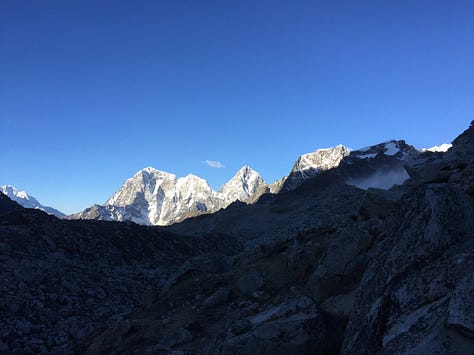
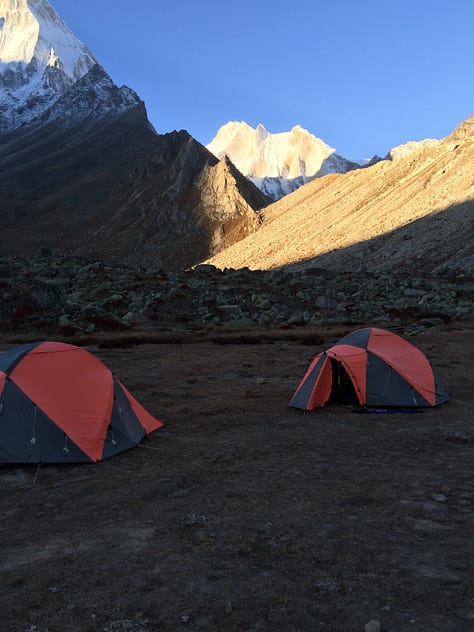
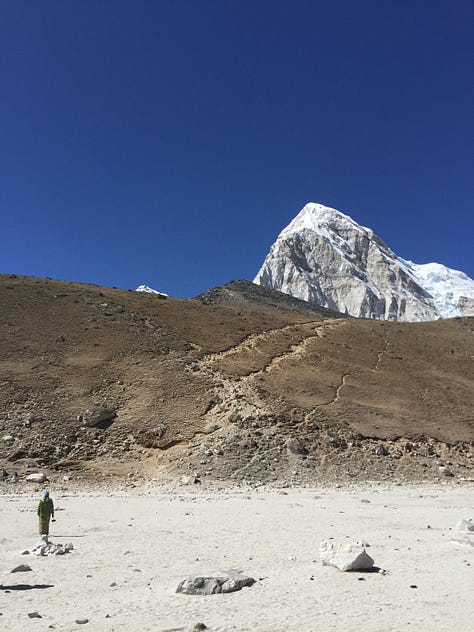
In those walks, ambition softened. What once felt like armor became something lighter: an intention, not an identity.
That same intention guided me through the hardest steps away from Cequity. At the office, I had a favorite meeting room with a view of the gulmohar trees that always seemed to bloom. I loved that room. It became my refuge, where I could think clearly about what mattered most. I remember sitting there, looking out at the Gulmohar tree-lined street below, as I wrestled with another big decision: to leave the company I had co-founded and step into an entirely different future. The view outside steadied me and grounded me in nature's rhythms, giving me a sense of strength to take the call my heart was telling me to take. Another cracking sound warned me of an avalanche brewing inside me, this time not intending to warn me away from danger but instead towards something more meaningful.
The Thaw
Every glacier eventually returns to water, finding new paths down mountainsides to nourish valleys below. Our frozen selves follow similar patterns of transformation.
Annapurna didn't give me new answers. She gave me something more vital: the warmth that allowed the thaw to start, the slow melt that nourished me by disrupting my "status quo," showing me the cracks and letting discomfort be the soil where something softer could take root.
The thaw is never sudden. It comes in small bursts and a slow, relentless melt.
You don't have to summit to be transformed. You just have to walk long enough to meet yourself.
And when you do, the question is no longer, "What can I conquer?" It becomes, "What can I let melt?"
✨ Final Reflection: From Summit to Stream
In the end, maybe the real summit isn't outside us. It's the quiet place where what was frozen finally begins to move.
Like mountain snow that transforms from edgy ice to a flowing stream, we can, too, melt from rigid ambition into a more flowing identity. The journey down from the peaks isn't a descent but a transformation—from the rigidity of ice to the flexibility and ease of water, finding new paths, and ultimately joining something vaster than we once believed possible.

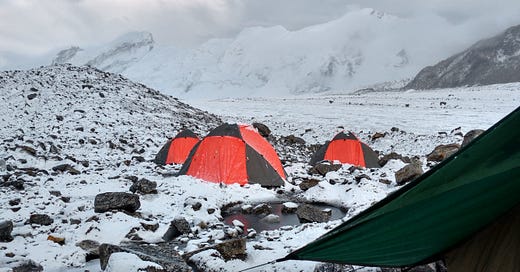



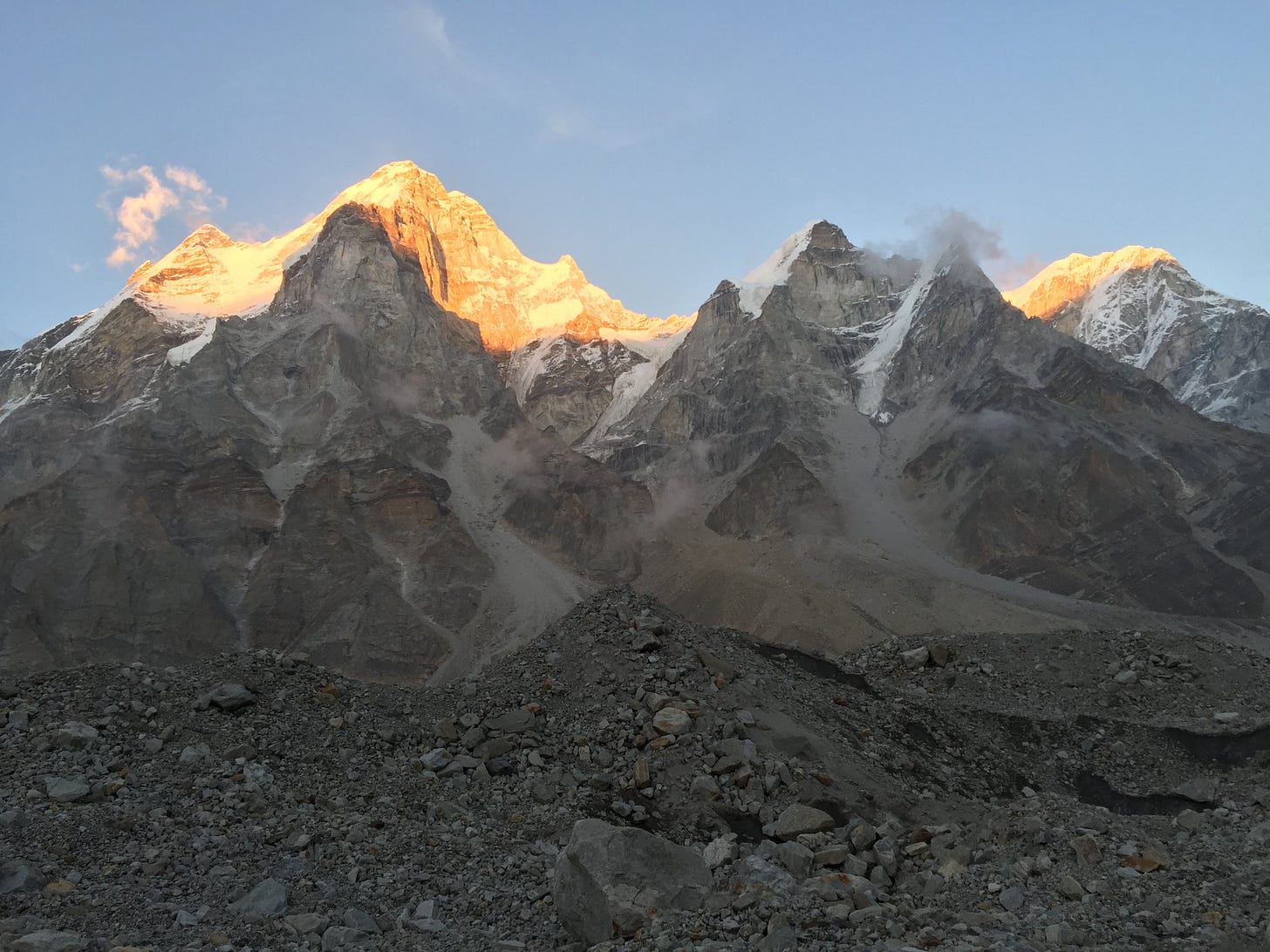
Hi Ajay, enjoyed both your pieces. It’s not necessarily the ‘coming of wisdom with time’ but more a visitation. An awareness.
Thank you for sharing your thoughts.
Dear Ajay, your piece is a cause for reflection. I love trekking , for me a trek is like a simple walking meditation, where you fall into the rhythm of one step behind the other. So the moment I quit my corporate job of 20 years, i set off for a few treks. I think I still had some smell of ambition around me. Wanted to tackle high peaks, prove to myself and perhaps others that quitting was for a reason. And also to push myself physically to train for a goal. My fear that i was not good enough for the journey was bigger than my actual ability to do so. The feeling on finishing was phenomenal, made me weep with gratitude .That melting of heart that you mentioned happened at the peak, it stayed in coming back to the city. In my mind I like to imagine my corporate self like a cheetah with muscles that ran up the mountains full stride, till it came to one that made it stop to think. As the Cheetah lay on its side, It woke to realise that ti had become a teddy bear that only wants to enjoy each breath of air and have deep conversations with the likes of Pooh. Loved your writing, it is poetry in prose and a reflective diamond. Warm regards Deepika.